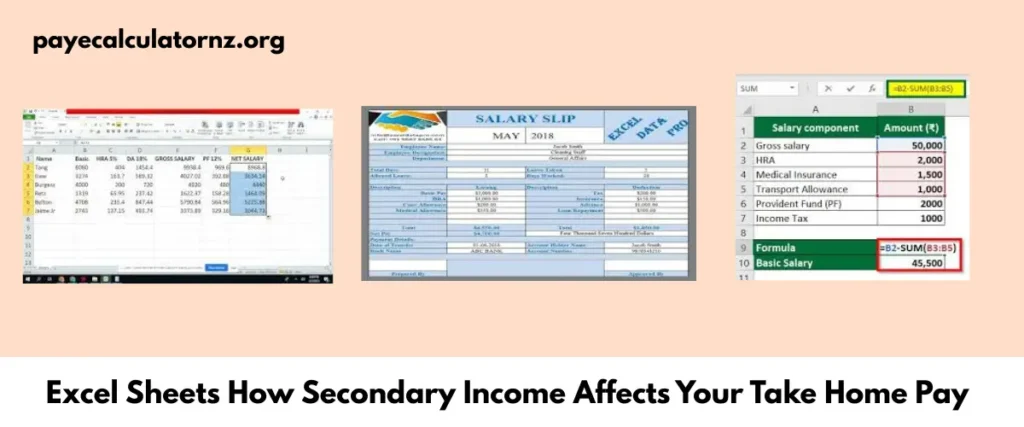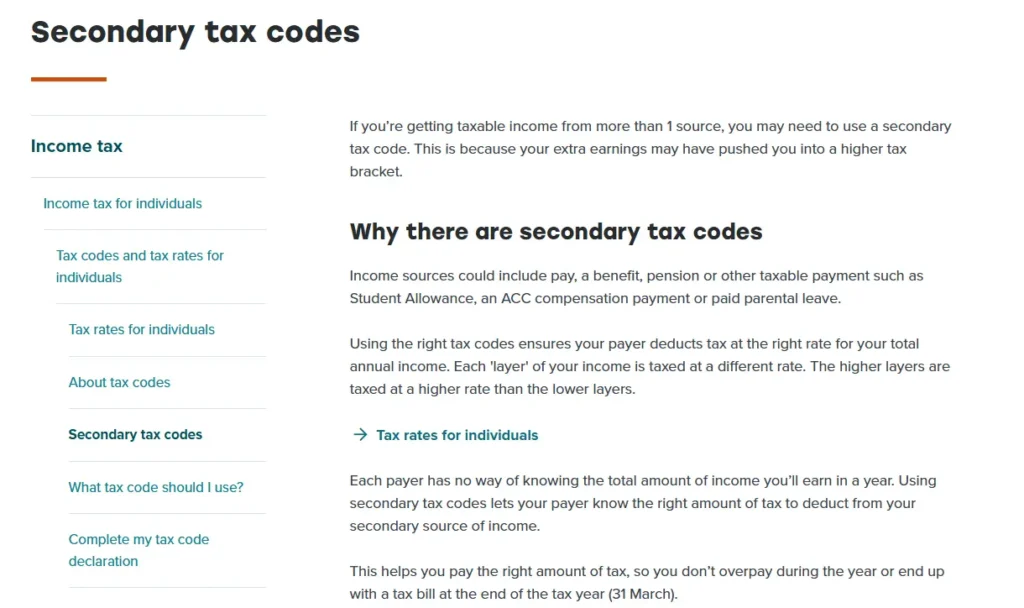How Secondary Income Affects Your Take Home Pay
Kia ora! Got a side gig in New Zealand? Secondary income, like money from a second job, boosts your earnings but comes with unique tax rules. Using the right secondary tax code ensures you keep more of your take home pay and avoid a surprise tax bill at the tax year end (March 31). This guide explains secondary tax codes (SB, S, SH, ST), their tax rates, how they impact your income, and tips to avoid overpaying. Try our PAYE Calculator NZ to see your net pay instantly.

What Are Secondary Tax Codes?
Secondary tax codes tell your employer or payer how much income tax to deduct from your extra job. In New Zealand’s PAYE system, your main income source uses a primary tax code (like M or M SL), while additional jobs use secondary tax codes. These codes ensure the right amount of tax is deducted based on your total income, including ACC levies and student loan repayments if applicable.

Common Secondary Tax Codes
- SB: For income up to $15,600 (10.5% tax rate).
- S: For income between $15,601 and $53,500 (17.5% tax rate).
- SH: For income between $53,501 and $78,100 (30% tax rate).
- ST: For income between $78,101 and $180,000 (33% tax rate).
- SA: For income over $180,001 (39% tax rate).
If you have a student loan, add “SL” to the code (e.g., S SL), which includes 12% repayment on income above $24,128 (2025 threshold).
Example: Earn $40,000 from your main job (M code) and $10,000 from a side gig? Use the S code for the side gig, taxing it at 17.5%.
Source: Inland Revenue: Secondary Tax Codes
How Secondary Income Affects Your Take-Home Pay
Secondary income increases your total income, pushing you into higher tax brackets. Unlike your main job, which uses progressive tax rates (10.5% to 39%), secondary income is taxed at a flat rate based on your estimated annual income. This ensures your tax reflects your combined earnings but can reduce your take-home pay if not managed correctly.
Impact on Your Pay
- Higher Tax Rates: Secondary tax codes apply higher rates to account for your main income. For example, the S code taxes your side gig at 17.5%, even if the income is small.
- Overpayment Risk: Using a code with a higher rate (e.g., ST instead of S) takes more tax, lowering your net pay.
- Underpayment Risk: Using a code with a lower rate (e.g., SB instead of SH) may lead to a tax bill at year-end.
Example:
- Main job: $40,000 (M code, taxed at 10.5%–17.5%)
- Side gig: $10,000 (S code, taxed at 17.5%)
- Without the S code, your side gig might be taxed at a lower rate, causing a tax bill later.
2025 Tax Rates with ACC
| Income Range | Tax Rate | Total PAYE (with ACC) |
|---|---|---|
| $0–$15,600 | 10.5% | 12.17% |
| $15,601–$53,500 | 17.5% | 19.17% |
| $53,501–$78,100 | 30% | 31.67% |
| $78,101–$152,790 | 33% | 34.67% |
| $152,791–$180,000 | 33% | 33% |
| $180,001+ | 39% | 39% |
Source: Inland Revenue: Tax Rates
How to Choose the Right Secondary Tax Code
Choosing the correct tax code for your secondary income ensures you pay the right amount of tax. Follow these steps:
- Estimate Your Total Income: Add your main job and side gig earnings. Include student loan status or eligibility for the Independent Earner Tax Credit (IETC) ($24,000–$70,000 income, no benefits).
- Use IRD’s Tax Code Tool: Answer questions on the IRD’s tax code tool to find your secondary tax code.
- Complete the IR330 Form: Submit the IR330 Tax Code Declaration to your side gig’s employer. Update it if your income or job changes.
- Check Your Payslip: Ensure the tax rate matches your code. If not, contact your employer or Inland Revenue.
Example:
- Main job: $40,000 (M code)
- Side gig: $10,000 (S code, 17.5%)
- Total income: $50,000
- Use the S code for the side gig to avoid overpaying tax.
How to Avoid Overpaying Tax
Overpaying tax on secondary income reduces your take-home pay. Here’s how to avoid it:
- Pick the Right Code: Match your secondary tax code to your total income. For example, if your total income is $50,000, use S, not SH.
- Update Your IR330: Start a new job or pay off a student loan? Submit a new IR330 form to your employer.
- Review Payslips: Check that your tax deductions align with your tax code. Errors can lead to overpayment.
- Consider a Tailored Tax Code: If your income varies, apply for a tailored tax code to fit your situation.
- Use Our Calculator: Our PAYE Calculator NZ lets you test different tax codes to see their impact on your net pay.
Example: Using ST (33%) instead of S (17.5%) for a $10,000 side gig takes an extra $1,550 in tax, cutting your take-home pay. Our calculator helps you choose wisely.
Consequences of Using the Wrong Tax Code
- Overpayment: A higher tax code (e.g., ST instead of S) deducts more tax, reducing your money each payday. You may get a refund after filing your tax return.
- Underpayment: A lower tax code (e.g., SB instead of SH) means less tax deducted, leading to a tax bill at year-end.
- Non-Declaration Rate: No IR330 form? Your employer deducts tax at 45%, slashing your take-home pay.
Example: If you use M for both a $40,000 main job and a $10,000 side gig, you might underpay tax, owing Inland Revenue later.
Example: Calculating Take Home Pay with Secondary Income
Let’s break down a real-world scenario:
- Main Job: $40,000/year (M code)
- Side Gig: $10,000/year (S code)
- Student Loan: None
- Tax Year: 2025
Main Job Tax (M code)
- $0–$15,600: 10.5% = $1,638
- $15,601–$40,000: 17.5% = $4,275
- Total tax: $5,913
- ACC levy: $40,000 × 1.6% = $640
- Take-home pay: $40,000 – $5,913 – $640 = $33,447
Side Gig Tax (S code)
- $10,000 × 17.5% = $1,750 (tax)
- $10,000 × 1.6% = $160 (ACC levy)
- Take-home pay: $10,000 – $1,750 – $160 = $8,090
Total Take-Home Pay
- Total income: $40,000 + $10,000 = $50,000
- Total tax and levies: $5,913 + $640 + $1,750 + $160 = $8,463
- Net pay: $50,000 – $8,463 = $41,537/year
Note: Using our PAYE Calculator NZ shows this breakdown instantly, including KiwiSaver or student loan deductions if applicable.
Why This Matters
- Employees: The right secondary tax code maximizes your take-home pay and avoids tax surprises.
- Employers: Correct codes ensure PAYE compliance, reducing errors for your business.
- Migrants and Seasonal Workers: Understanding codes like NSW for seasonal workers helps you manage tax correctly.
- Students: Adding SL to your code accounts for student loan repayments, keeping your budget on track.
